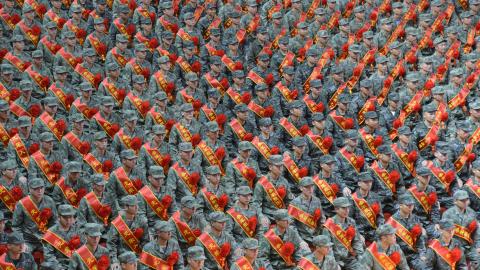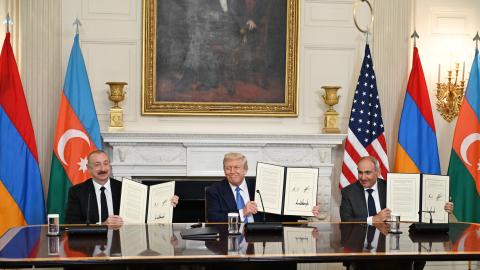In a recent editorial that appeared in the Wall Street Journal, Abdurrahman Wahid, Indonesia’s former president and the former head of the Nahdlatul Ulama, the largest Muslim organization in the world, gave a far-ranging and detailed account of what he views as the “global struggle for the soul of Islam.” Wahid described what he sees as the current state of that struggle, especially the strength of extremist ideology, the sources of that strength, the great dangers to which both the Muslim and non-Muslim world are exposed, and the tasks to which these dangers oblige us. We recommend this article, which we’ve re-published in this issue of Current Trends in Islamist Ideology, to very serious reading and reflection.
Here, we will limit ourselves to noting only one of the tasks mentioned by Wahid: “we must identify [the] advocates of [this virulent ideology], understand their goals and strategies [and] evaluate their strengths and weaknesses.” Nothing better describes the purpose of this journal. In accord with Wahid’s emphasis on the truly global character of the radical Islamist movement, we have aimed to provide the broadest possible coverage in this journal. In this, the third, issue we continue that practice with four articles that have a regional or national focus, ranging from South and Southeast Asia (India, Malaysia, and Bangladesh) to Western Europe (France).
Another set of articles focuses on the greater Middle East and, in particular, what has emerged as the main axes of ideological discussion within Islamism and radical Islam. With regard to the latter, it is worthwhile observing that there are several main lines of thought as well as action that now often vie with one another for predominance within the worldwide Islamist movement. The debate among these disparate ideological trends is often fierce, and serves to provide an overall framework for understanding it.
Several articles in this issue describe and analyze that framework. Some address the current activities of al-Qaeda, especially in Iraq, including the recently intercepted communication of Zawahiri to Zarqawi and the implicit dispute between them, and the open dispute between Zarqawi and his former mentor al-Maqdisi. Another article provides an analysis over the internal debate within the Egyptian Muslim Brotherhood. A third axis—the Islamist debate over “Euro-Islam”—was discussed in the last issue of this journal. This debate, which will continue to be a focus of this journal, is linked to both the transnational and Middle Eastern debate by the prominent role of figures connected to the International Organization of the Muslim Brotherhood.
The relationship and potential dynamic among and between these various ideological trends is still of course uncertain. However, it may be expected that they will have an important impact on the worldwide Islamist movement. For the present, some dynamics can and ought to be highlighted.
One is the ambiguity regarding authority within the Islamist movement and, indeed, within the contemporary Muslim world more generally. The assumption of Islamic “legal” authority, which had historically been the preserve of the traditional ulama class, by Islamist and jihadi leaders—Bin Laden, Zawahiri, Zarqawi, Maqdisi etc.—who lacked traditional credentials of authority continues apace. While this has obviously created problems for traditional religious authorities and institutions, it is problematic for the Islamist and jihadi movements as well. This is evident in a variety of intra-Islamist disputes, some specific to al-Qaeda others specific to the Muslim Brotherhood and other Salafist organizations. In particular, one may note that although all Islamist movements claim Salafist or ancestral authority, this has not necessarily led to privileging the position of the “elders” within the movement, as we see today in the case of Zarqawi and others. There is an ongoing struggle between older and younger generations of jihadi and Islamist leaders. Eventually, the Islamist movement may mount a debate over authority as such.
A second factor is the impact of contemporary circumstances and events on the ideological debate. This is most obvious in the case of Iraq and the engagement of al-Qaeda and other Islamist groups in the broader Sunni insurgency. For obvious reasons, the War in Iraq has come to occupy a central place in jihadi activity that is, in many respects, analogous to the role the Afghan Jihad played in an earlier era. At the operational level, this is to be seen in the degree to which terrorist recruitment in Europe and elsewhere has focused on Iraq as well as the degree to which terrorist activity elsewhere takes its bearings from this war.
But the Iraq Jihad also presents a number of ideological issues for the worldwide Islamist movement with which it has been obliged to struggle. So far, that struggle has been without any satisfactory resolution, as is evident in Zawahiri’s letter to Zarqawi, which insists on seeing events within Iraq in terms of the broader objectives of the global Islamist movement. In this issue, Shmuel Bar provides an excellent analysis of the themes discussed in this letter, as well as the authenticity of the letter. But it is useful to highlight one aspect that is less fully treated: Zawahiri’s appeal to Zarqawi that the Islamist struggle in Egypt, Syria and Palestine be seen to be as important as Iraq if not more so.
Of course, the relative restraint of Zawahiri’s letter makes it difficult to say exactly the reason for this emphasis. Since Zawahiri is an Egyptian, it may be that the letter simply reflects a special attachment to the Islamist struggle in Egypt and its environs. But it is equally if not more likely the case that the letter reflects Zawahiri’s considered judgment about the opportunities and liabilities of the Iraqi War. This is strongly suggested by his criticism of Zarqawi’s radically anti-Shiite strategy and tactics. While affirming his own fundamental hostility to Shiism, Zawahiri points out to Zarqawi the fact that the majority of Iraqis are Shiites. This, Zawahiri states, must be taken into account in planning for the future, especially should the Iraq Jihad succeed in its immediate objective of driving the United States out of Iraq. For Zawahiri, the success of the insurgency in Iraq may well present an opportunity for setting up an Islamic state—a necessary first stage in the global Islamist struggle to lay the foundations of the new Islamic Caliphate. But such an opportunity might well be forestalled without the support of Iraq’s Shiite majority.
Zawahiri is surely correct in pointing this out. But following this line of thought, one may pose some questions that Zawahiri himself may be addressing to Zarqawi: Given the Shiite majority in Iraq, how could Iraq serve as the base for the worldwide radical Sunni movement? Are there circumstances under which the Shiite majority would make common cause with Sunni radicalism? Or is it more likely that Iraq would have to fragment in such a way as to produce a smaller, radical Sunni state? Zawahiri does not address or answer these questions, but the problem with which they are concerned may explain his emphasis on the Sunni Arab heartland of Egypt, Syria, Palestine.Perhaps he is suggesting that only these territories can serve as a proper base for the Islamist movement, however much their appropriation would in fact be greatly assisted by securing a radical Sunni base in some part of Iraq.It would also explain Zawahiri’s professed concern not only with Zarqawi’s hostility to Shiism but his actual or potential hostility to all varieties of Sunnism other than his own. Zawahiri urges Zarqawi to at least consider the short term necessity for a “big tent” approach to various Sunni theological schools that may be, from al-Qaeda’s perspective, less ideologically pure.
Though the parameters of Zawahiri’s full reflections are not entirely clear, we may perhaps look to future communications for some clarification as the underlying problems are important and will not go away.
The impact of current events and circumstances and the questions they pose may present problems to the radical movement in other ways. The perennial theological and political debate within the Islamist movement about whether dawa, i.e. ideological preparation, or jihadist violence should take precedence is at the core of the quarrel between Maqdisi and Zarqawi and has, of course, been brought to the fore by the events in Iraq. But a kind of analog in the form of a debate about the relative importance of dawa and politics has also emerged within the Egyptian Muslim Brotherhood. This is at least partially a consequence of the American democratic initiative and the pressure it has exerted on the Egyptian regime. The present and future importance of this development and internal debate within the Muslim Brotherhood is excellently described and analyzed here in this volume by Israel Elad-Altman.




















